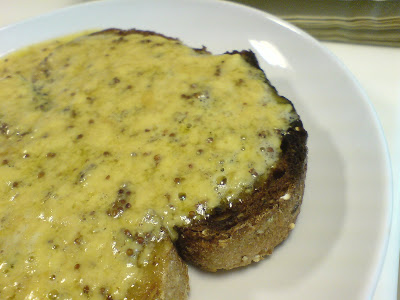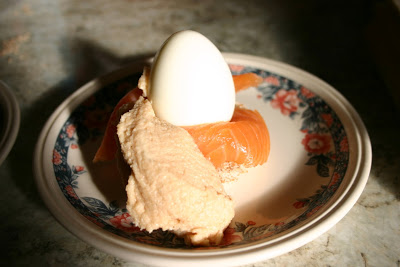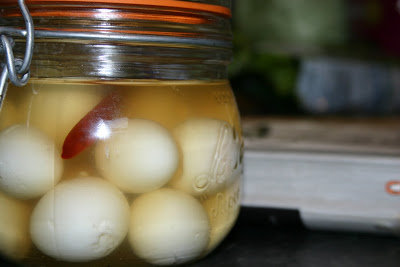Tag: 2: Cheese and Egg Dishes
#420 A Fricassee of Eggs
This fricassee of eggs serves eight as a first course, but can easily be scaled up or down.
#413 Fish Soufflé
#408 Little Cheese Soufflés
This recipe appears to be far too good to be true; there is no béchamel sauce, no whipping of egg whites, no gentle folding and no ban Marie. All one has to do is mix the ingredients in the right order and bake! Obviously this was the one.
This mixture makes enough for 8 ramekins:
Grate 8 ounces of Lancashire cheese, setting a couple of tablespoons aside for later. Whisk together well 4 large eggs, and mix in ¼ pint each of single and double cream along with the cheese. Season with salt and both black and Cayenne peppers. Jane has a secret ingredient too; a rasp or two of freshly grated nutmeg.
Butter your ramekins and split the mixture between them, making sure there is a half-inch gap between mixture and ramekin rim. Mix together the cheese you put aside with two tablespoons of breadcrumbs and adorn each pot with the mixture.
#407 Seftons
This recipe comes from the distinguished French Cook Louis Eustache Ude, chef to the Earl of Sefton. He came from good cooking stock himself; his father was chef to King Louis XVI.
Ude was quite a character, there’s a great story of him being hauled in front of a magistrate after he was found selling roast grouse on his menu before the 12th of August (the date from which the gamed season begins. See here for a post all about that). He was given a fine and sent on his way.
The next day, the Scottish Laird who had reported Ude to the police returned to Ude’s restaurant to make sure he was abiding by the rules. Pleased to see there wasn’t a morsel of the offending bird on the menu, he ordered Salami de fruit défendu, i.e. Salmi of Forbidden Fruit, which turned out – of course – to be grouse! The cheeky devil.
There was none of this nonsense when he worked for the Earl of Sefton though as they goton like a house on fire, except for one day when he left his service because Ude spotted the Earl’s son adding salt to some soup he made. Offended by this, he turned on his heel and left.
This recipe is essentially a savoury custard. It could only work with a home-made stock though. I imagine it would be excellent nourishing food for someone that is ill. The little custards can be served in their ramekins or turned out onto a plate.
Jane suggests to use a veal stock, but any stock can be used. On the other blog I recently wrote up a recipe for such a stock. For these sorts of dishes where the stock is the star of the show, you need to make your own stock, otherwise you risk it tasting of Cuppa Soup.
Anyway, that’s enough waffle. On with the recipe!
Bring one pint of good, clear, home-made stock to a boil and whisk it into 6 beaten eggs just as you would with a regular custard. Add the grated zest of a lemon, ¼ tsp of ground mace and season with salt and Cayenne pepper, then and whisk in 4 tbs of clarified butter.
Place your ramekins – you’ll need 6 to 8, depending on size – in a deep roasting tin and pour the custard into them and cover with foil. Pour boiling water into the tin, technically turning it into a ban Marie, and carefully slide the tin into an oven already preheated to 180⁰C and bake for 12 to 20 minutes, or until the custards are just set and still have a good wobble on them. Serve straight away with thin, crisp toast, says Good Lady Grigson.
#407 Seftons. These were great, light and satisfying, even though they sound a little odd. I’m thinking that should I ever get my premises, they will definitely go on the menu; they are delicious, light, subtle and very satisfying and could very easily made vegetarian. I imagine a good mushroom stock would work very well as an alternative to veal. 8/10
#351 Potted Cheese
#254 Gloucestershire Cheese and Ale
After a slow few months, it is time to get Neil Cooks Grigson up and running again. I’m settling in here in Texas now, which means I’m getting more than a little homesick. What better way is there to get over it than making some nice English foods?
I was a bit hungover this morning so this recipe I hoped would be the perfect cure: carbs, fat and salt plus the hair of the dog, the perfect combination. The cheese required for this is single or double Gloucester. Good cheeses are hard to find in Houston – typical American cheeses are not the best and anything I considered proper (i.e. European) are pretty expensive and/or difficult to find. However I did find an excellent shop which is set out like a big market called the Epicurean Market. There’s a few of them in Houston and they sell a lot of European foods. So finding places like this is great for my blog.
This recipe is quick and easy and full of delicious calories:
Start by slicing some double or single Gloucester cheese thinly and arrange them in a small ovenproof dish. Spread some good mustard over the top – Griggers suggests Tewksbury wholegrain, but any piquant wholegrain will be good – and then pour over enough ale to just cover the cheese. Bake in a moderate oven until the whole things melts and becomes a sauce. Meanwhile, toast some wholemeal or granary bread, arrange on a plate and then moisten with a little warmed ale. Lastly spoon over the melted cheese and serve with a glass of ale.

#254 Gloucestershire Cheese and Ale. A good traditional cheesy dish very similar to those served in Gentlemen’s Clubs in Edwardian times. Very rich but the mustard and bitter ale helped to cut through the cheese. I was right in that it really helped to sort out my hangover too! 7.5/10
#250 Oeufs Mollets Christophe
Well I was hoping to do a really special 250th recipe, but due to my busy schedule I didn’t get round to it. Instead what I had to do was try and empty my freezer of as many things as possible before I left for Texas, which meant a lot of fish after my big order from The Fish Society (an excellent website, by the way). So it is quite bizarre that this little landmark recipe has to have the least English name! The ingredients are very English and despite the French name, the dish was created by an Englishman called Christopher Snow. The exciting thing about this recipe, is the inclusion of the smoked cod’s roe – quite a cheap ingredient, but tricky to find, and one I’ve never eaten before. It looked quite scary and alien-esque in its packet and I wasn’t sure about it, but it is part of the fun of this experiment. Plus none of the meat or fish has been bad thus far….
This is a very easy dish to prepare as there is hardly any cooking required at all. The recipe serves four, but it can be easily increased or decreased in ratios for any number:
Start off by boiling four large eggs; Griggers is very precise about this, so listen good. Place the eggs into already boiling water and leave for precisely six minutes (seven if they are extra large eggs). Remove and run under the cold water to cool them down. Meanwhile, cut four slices of wholemeal bread and cut them into circles, removing a smaller circle from the centre and butter them and then place them in the centre of a plate. Now prepare the roe: peel away the skin of a four ounce roe and beat the pink centre with four tablespoons of double cream until thick, this should only take thirty seconds and then season with black pepper. Peel the cool eggs and wrap a piece of smoked salmon around each one and place it in the little brown bread stand you have made. Lastly, spoon the roe sauce over the egg (this is quite tricky as it is quite thick, so I did a quenelle instead, pretty posh, eh?).

#250 Oeufs Mollets Christophe. “Occasionally when one goes out for a meal, some dish appears which is so delicious and simple that one is angry not have thought of it oneself” says the Grigson. Well I wouldn’t go that far, but it was pretty good. The eggs were cooked to perfection using her method – the yolks were still runny and creamy and complemented the smoked salmon very well (a classic combination, of course). The smoked cod’s roe was really delicious too, rich and heady with natural hot smoke, the only problem was that it was so very rich and it needed some lemon juice to cut through it, I think. That or just less of it. I think with a little alteration, this could be really excellent. 7/10.
#240 Smoked Sprats (and #232 Pickled Eggs revisited)
‘An inexpensive luxury’, says Jane Grigson of smoked sprats. That sentence should be now changed to: ‘An expensive luxury’. How times have changed. I’m not sure why smoked sprats aren’t more widely available because fresh sprats certainly are, so it’s not like they are hard to come by. The only place I’ve seen them is The Fish Society’s website. You eat smoked sprats whole, rather like whitebait, the difference of course, is that they are quite a lot bigger than tiny whitebait.
Anyways, my friends Simon and Rachel came over to visit after their super-amazing trip around South America. They blogged it, natch, have a look-see at it here. I thought smoked sprats would make a great starter. Because my friend Stuart – a staunch vegetarian – came along too so I served some pickled eggs, remember them? Have a look here to see they were made.

#240 Smoked Sprats. I really liked these alot. The problem of bones/guts was, in the end, a non-issue. The bones were just the right side of not being too crunchy or sharp. They were quite strongly smoked, but also sweet in flavour and not over-powering like some cured fishes can be. If you see some, be sure to give them a go. 8.5/10
#232 Pickled Eggs

First of all, you need to make your pickling vinegar and the amount you required will depend upon the number of eggs you want to pickle. I had dozen quail’s eggs and so only needed half a pint to fill one large jar. I’ll give you the amounts for two pints of pickling vinegar as provide by Griggers herself, you can alter amount as required. Pour two pints of white wine vinegar into a pan along with half an ounce each of fresh peeled ginger, mustard seeds and white peppercorns plus three small dried chillies. Bring to the boil and simmer for five minutes. Strain the vinegar and allow to cool. Meanwhile, place the eggs in another pan and cover with cold water. Bring to a boil and allow to simmer for two minutes for quail’s eggs and ten minutes for hen’s eggs. You would do well to time the simmering, you don’t want to guess the times and have over-cooked black-ringed yolks. Let the eggs cool also. Shell the eggs and arrange them tightly in a sterilised jar – if hen’s eggs arrange them upright; if quail’s don’t bother as they are far too fiddly. Pour over the spiced vinegar, tuck in the dried chillies and seal tightly. Make sure you use non-metal lids as the metal will be corroded by the acidic vinegar. Leave for two weeks before using in salads or as an hors d’oeuvre, says the Grigson. I might use them as an excuse to have fish and chips.














